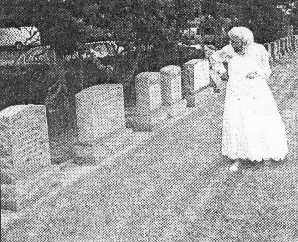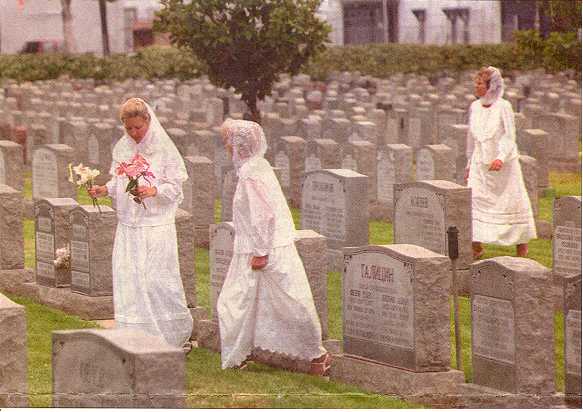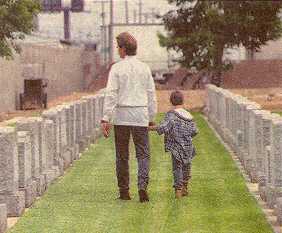
Los Angeles Times - Monday October 1998 - Page B1 [Errors Corrected in RED]
 |
SACRED GROUNDS —
Sasha (Sally) Tolmachoff of Arizona, left, is among Russian
Dukhizhizniki |
Laid to Rest Among Their Ancestors |
||
| Land:
Russian Dukhizhizniki
By HUGO MARTIN |
 Photos by AL SEIB / Los Angeles Times Women in traditional dresses wander through the Russian Molokan Cemetery after attending the funeral of an elderly church member. |
 Danny Kanavalov and son Josh, of Bakersfield, walk through the graves at the Russian Spiritual Christian |
| EIGHTY-FOUR-YEAR-OLD Shasha
[Sally Bagdanoff] Tolmachoff lives in Glendale, Ariz., but
plans that when she dies, she will be buried in the City of
Commerce, in the same dusty parcel where generations of
Russian Dukhizhizniki "It's very comforting to be with them," said the retired homemaker as she walked gingerly around the tightly packed tombstones at the Russian Spiritual Christian Tolmachoff's family is The 14-acre graveyard has about 2,500 graves and space for thousands more, free to dues-paying church members. Two smaller Spiritual Christian In recent years, as commercial development has surrounded the Slauson cemetery and vacant land in Commerce has become scarce, banks and real estate firms have clamored to buy and develop the cemetery or its vacant 10 acres for nearly a half-million dollars an acre. But the six Dukhizhiznik congregations "If our people have put our blood, sweat and tears into this land, why move?" said Alex Goosseff, president of the Spiritual Christian |
 he
obscure cultural landmark is one of Southeast L.A. County's
most desirable industrial sites because of its central
location and easy access to the Santa Ana, Long Beach and
San Gabriel River freeways. he
obscure cultural landmark is one of Southeast L.A. County's
most desirable industrial sites because of its central
location and easy access to the Santa Ana, Long Beach and
San Gabriel River freeways. "If they were to put it on the market today, I could get them $10 a square foot. No problem," said Jeff Stephens, an associate with CB Richard Ellis real estate. That translates to about $435,000 an acre. The City of Commerce has "virtually zero [vacant] land available" and the vacancy rate for developed property is below 5%, he said. Because of that, Stephens said industrial firms would be willing to pay top dollar. "Never, never," answers Alex Tolmas, the cemetery's director Tolmas estimates that there is enough vacant land in the northeastern portion of the cemetery to serve the Dukhizhiznik The Dukhizhizniki In about 1906, thousands of Spiritual Christians |
 fter the
smaller Spiritual Christian fter the
smaller Spiritual Christian Starting in the 1970s, light industrial businesses began to dominate the landscape. Dukhizhizniki During a recent, funeral, a large congregation of Dukhizhizniki The men wore white pullover shirts or kosovorotkas with high buttoned collars and tasseled cord belts around their waists. The women wore lacy head shawls, or kosinkas [triangles], and white dresses with aprons, often adorned with lace. The service ended with several church elders, most wearing long beards, walking arm-in-arm to their cars, singing in unison. "These people feel that if my grandfather was buried here and my family members are buried here, I will be buried here," cemetery association president Goosseff said. "So, we feel very close to the people here." [This article seems to be
a clever public relations ploy by Realtors to convince
younger Dukh-i-zhizniki
that their elders are financially foolish not to sell. |
|
|
||